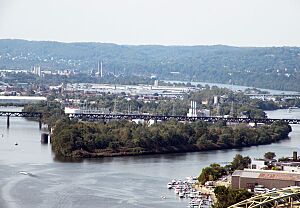Brunot Island facts for kids
Brunot Island is a 129-acre island located in the Ohio River. It's officially part of the Marshall-Shadeland neighborhood in Pittsburgh, Pennsylvania. The island got its name from Dr. Felix Brunot. He and his family settled there in the late 1700s.
A famous event happened on the island in August 1803. Dr. Brunot's family welcomed the Lewis and Clark Expedition! This was a very important journey across America. Today, Brunot Island is home to the Brunot Island Generating Station. This is a large power plant that makes electricity.
The Ohio Connecting Railroad Bridge crosses the Ohio River right at the island. But the island isn't connected to the land by roads. So, if you want to visit, you'd need a ferry! However, the island is mostly for the power plant. Workers at the plant use a special walkway on the railroad bridge to get to work. This walkway is not open to the public.
From 1903 to 1914, Brunot Island had a different purpose. It was home to the Brunots Island Race Track! Imagine horses racing on this island long ago.
Brunot Island Power Plant
The Brunot Island Generating Station is a big power plant. It uses fossil fuels like oil and natural gas to create electricity.
- What it is: A power plant that uses oil and natural gas.
- How much power: It can produce 315 megawatts (MW) of electricity. That's enough to power many homes!
- When it started: It began making power in 1972.
- Who owns it now: The company NRG Energy owns and operates the plant.
How the Power Plant Works
The power plant on Brunot Island uses different types of machines to make electricity.
- Oil-fired plants: There are three smaller power units that run on oil. These are called "simple cycle" plants. They are often used when there's a very high demand for electricity, like on a hot summer day. Together, these three units can make 53 MW of power.
- Natural gas plant: There's also one larger power unit that uses natural gas. This one is a "combined cycle" power plant. This means it's more efficient because it uses heat from one process to create more electricity in another. This single unit can generate 262 MW of power.
See also
- In Spanish: Isla Brunot para niños



